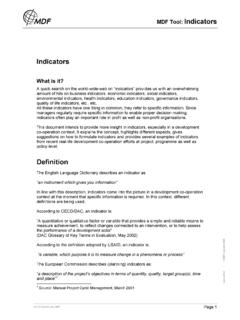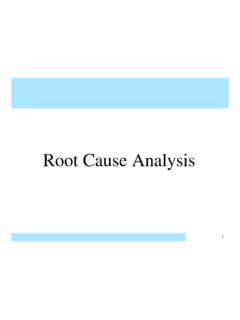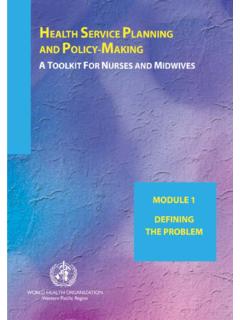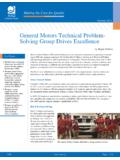Transcription of 03 Problem tree analysis - …
1 MDF Tool: Problem tree analysis ref:03 Problem tree MDF Page 1 MDF copyright 2005 Problem tree analysis What is it? The Problem tree method is a planning method based on needs, however it is not a mechanical translation of problems into objectives. While going through the process, taking the different steps, there is continuously room for opportunities, new ideas and contributions from the involved parties. Problem tree analysis should be followed by actual project planning, with the Logical Framework approach. Alongside, or interwoven with the steps of Problem analysis (at target group level) and project planning (for the target group), one should analyse the capacity and intentions of stakeholders and the wider institutional context, so that relevant and realistic choices can be made on who does what.
2 Participatory methods The better and more participatory the method for identification, the more likely it is that different aspects of poverty and inequality among the poor will appear, such as those of gender, age, class and ethnicity. It also gives particular insight in the distribution of power within the target groups. The challenge is how to manage these differences and address the varying needs, interests and opportunities with them (from Building bridges in PME). A successful outcome of using participatory methods depends on the familiarity of the facilitator with the method, the attitude of the facilitator and the implementers and the amount of time that is reserved to do the identification and planning. Particular efforts are made to involve all members of a community into participatory action planning. What can you do with it? Basic (sub-) questions address the real needs of the beneficiaries Results This process will result in an image of reality', enabling the formulation of projects that comprise objectives that have been accepted and supported by all parties concerned.
3 Information collected through these methods can be used as input for a project planning workshop. MDF Tool: Problem tree analysis ref:03 Problem tree MDF Page 2 MDF copyright 2005 How to use it? Process A properly planned project addressing the real needs of the beneficiaries is necessarily based upon a correct and complete analysis of the existing situation. The existing situation should be interpreted according to the views, needs, interests and activities of parties concerned. It is essential that all those involved accept the plans and are committed to implement them. The Problem tree analysis belongs to the family of participatory planning techniques, in which all parties involved identify and analyse the needs together.
4 Participatory methods aim to create ownership and commitment among the involved parties ( beneficiaries, implementing organisations, local governments). Three stages in the analysis process in the Problem analysis method will be discussed: the analysis of problems related to the subject (the image of reality); the analysis of objectives (the image of a future, improved situation); the analysis of strategies (the comparison of different chains of objective). There are several complementary methods to analyse a situation: expert studies giving answers to questions as experts conceive them; interviews with representatives of concerned groups and organisations providing perceptions as existing within that particular group or organisation; a meeting, in which representatives of all parties concerned, including experts, discuss the same questions in a participatory way, often leading to an analysis , which is shared by all ( Participatory Rural Appraisal).
5 1 Problem analysis The Problem analysis is of major importance with regard to project planning, since it strongly influences the design of a possible intervention(s). It is the basis and the justification for the project design. The Problem analysis includes: verification of the subject of analysis ; identification of problems related to the subject; make and inventory of all problems perceived by all participants in the workshop; establishment of a cause-effect hierarchy between the problems; visualisation of the cause-effect relations in a diagram. It is important that all participants get the chance to express the problems they experience. After discussion and clarification by the Problem owner all problems should be respected. It is important to determine whether the different groups of people perceive the Problem in the same way; if not the Problem should be reformulated or split. For example, if the Problem mentioned is our family income is not sufficient , for a woman it could mean that she cannot buy vegetables and meat, whereas for the man in the family this could mean that he is not satisfied about the yields.
6 MDF Tool: Problem tree analysis ref:03 Problem tree MDF Page 3 MDF copyright 2005 Do s and Don ts in formulation of problems Don ts: Do s: No big balloons or big vague concepts, no infrastructure No absent solutions (danger: you block alternatives), we have a lack of money and thus children don t go to school No non- existing problems, no existence of NGOs (in former dictatorial countries possibly a Problem in the past) No formulation of interpretations, the government is lazy And further: explain abbreviations and jargon but but but but Be precise, there is no paved road from Chittoor to Mahabubnagar Instead, the Problem is: school fees are not affordable The Problem now is that there is no knowledge on how to run an NGO The government does not issue licenses After a common understanding of all problems is reached, the analysis is presented in the form of a diagram, or a Problem tree .
7 A Problem is never an isolated negative perceived situation, but relates to other problems. In the Problem tree the relations and hierarchy among all identified problems is expressed. Each stated Problem is preceded by the Problem (s) which cause(s) it, and followed by the Problem it causes itself. For example: the rice production in the low lands is decreasing due to the irrigation water not reaching the fields and due to the fact that there is an irregular supply of inputs for rice production. The Problem of a decreasing rice production itself contributes to the Problem of food shortages. 2 Objectives analysis After the Problem analysis follows the analysis of objectives. This analysis includes: the translation of the negative situations in the Problem tree into a realised positive state (the objectives) for example, 'low rice production' is converted into 'improved rice production ; verification of the hierarchy of objectives; visualisation of means-end relationships in a diagram.
8 Also in this step it is of importance that all stakeholders are involved. While transforming problems into objectives and verifying the hierarchy, discussion and feedback on the objectives is done. This helps building consensus amongst the stakeholders. It might also be necessary to reformulate some of the problems. Next, often the objective tree shows many objectives that cannot all be reached at once. Therefore, choices will have to be made. Certain objectives seem unrealistic, too ambitious or not feasible within the context of a possible intervention, so that other solutions need to be generated for the Problem concerned. However at this stage of the planning these choices are not yet made. Still all possible ways (objectives) to achieve the desired future situation are considered. 3 analysis of strategy (see further Strategic Options tool) MDF Tool: Problem tree analysis ref:03 Problem tree MDF Page 4 MDF copyright 2005 After having formulated the desired future situation the selection of possible interventions starts.
9 To analyse the strategies for implementation the following steps are taken: identification of the different possible groups of objectives contributing to a higher objective (clustering); choice of a strategy for the intervention, choosing the scope of the project (scoping). In the process of clustering and scoping it is important to realise that the aim is to contribute the maximum possible to an overall objective, keeping in mind the priorities of the beneficiaries, and the limitations and possibilities of the implementing organisation. In the diagram of objectives, the different objectives sharing the same nature can be considered to be clusters. The clustering should be based on common sense and should be of practical value in the planning stage. The clusters should be neither too broadly nor too narrowly defined. It concerns the identification and selection of potential alternative strategies towards realising all or some of the objectives. Clusters are made based on similarity of possible future activities, region or required expertise.
10 In the demonstration case these clusters are irrigation system, agricultural inputs, soil fertility and immigration. For each of these clusters a different type of expertise is needed. Out of the clusters, one (and often more) will be chosen and used as the strategy to achieve a future desired situation: the aims of the intervention. This is called scoping, or choosing a strategy. Based on a number of criteria, the most relevant and feasible strategy is selected. Unrealistic objectives should be excluded and objectives that certainly should be included should be prioritised. The criteria have to be chosen and agreed upon by all stakeholders. Examples of possible criteria: - priorities of beneficiaries - donor policy - expertise and experience of implementing organisation - fit with mandate of government authorities, sectoral policies - duration of implementation - contributions of different stakeholders - urgency - available human resources, institutions - contribution to overall objectives - available budget - inter-linkages between clusters - shift in power relations - positive/negative side-effects - gender and social diversity aspects - sustainability - likelihood of success - fit with mandate of implementing organisation Groundwork Preparatory phase 1 Define the subject The first thing to do is to define the subject based on which the exercise will be done.










